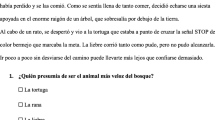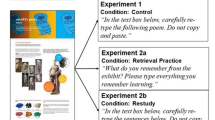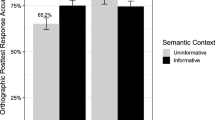Abstract
This study sought to determine whether contextual organizers presented before prose passages can improve learning and retention among students who have no prior knowledge of the subject. The researchers used two types of organizers — an image and its verbal equivalent. Students who were provided the organizers scored better than control students on tests given two weeks later, but the predicted advantage of images over verbal learning adjuncts did not appear.
Similar content being viewed by others
References
Ausubel, D. P. The use of advance organizers in the learning and retention of meaningful verbal material.Journal of Educational Psychobgy, 1960,51, 267–272.
Ausubel, D. P.Educational psychology: A cognitive view. New York: Holt, Rinehart & Winston, 1968.
Bartlett, F. C.Remembering. A study in experimental and social psychology. London: Cambridge University Press, 1932.
Bransford, J. D., & Johnson, M. K. Consideration of some problems of comprehension. In W. Chase (Ed.),Visual information processing. New York: Academic Press, 1973.
Bransford, J. D., & McCarrell, N. A sketch of a cognitive approach to comprehension: Some thoughts about what it means to comprehend. In W. B. Weimer & D. S. Palermo (Eds.),Cognition and the symbolic processes. Hilldale, N.J.: Erlbaum, 1975.
Brody, P. J., & Legenza, A. Can pictorial attributes serve mathemagenic functions?Educational Communication and Technology Journal, 1980,28, 25–29.
Duchastel, P. C. Illustrating instructional texts.Educational Technology, 1978, November, 36–39.
Duchastel, P. C. Research on illustrations in text: Issues and perspectives.Educational Communication and Technology Journal, 1980,28, 283–287.
Finn, J. D.Multivariance: Univariate and multivariate analysis of variance: Covariance, regression and repeated measures. Chicago: National Educational Resources, 1978.
Geshwind, N. Specializations of the human brain.Scientific American, 1979,241, 180–199.
Haring, M. J., & Fry, M. A. Effects of pictures on children’s comprehension of written texts.Educational Communication and Technology Journal, 1979,27, 185–190.
Hartley, J., & Davies, I. K. Pre-instructional strategies: The role of pre-tests, behavioral objectives, overviews and advance organizers.Review of Educational Research, 1976,46, 239–265.
Luiten, J., Ames, W., & Ackerson, G. A metaanalysis of the effects of advance organizers on learning and retention.American Educational Research Journal, 1980,17, 211–218.
Mayer, R. E., & Bromage, B. K. Different recall protocols for technical texts due to advance organizers.Journal of Educational Psychology, 1980,72, 209–225.
Paivio, A.Imagery and verbal processes. New York: Holt, Rinehart & Winston, 1971.
Patterson, F. Conversation with a gorilla.National Geographic, October 1978.
Peeck, J. Retention of pictorial and verbal content of a text with illustrations.Journal of Educational Psychology, 1974,66, 880–888.
Reynolds, J. H. Cognitive transfer in verbal learning.Journal of Educational Psychology, 1966,57, 382–388.
Reynolds, J. H. Cognitive transfer in verbal learning: II. Transfer effects after prefamiliarization with integrated versus partially integrated verbal perceptual structures.Journal of Educational Psychology, 1968,59, 133–138.
Royer, J. M. Theories of transfer of learning.Educational Psychologist, 1979,27, 53–69.
Salomon, G.Interaction of media, cognition, and learning. San Francisco: Jossey-Bass, 1979.
Schmid, R. F.Prior knowledge, content familiarity and the comprehension of natural prose. Unpublished doctoral dissertation, Arizona State University, 1977.
Schwartz, N. H., Kulhavy, R. W., & Finley, J. T.figurai organization of a prose passage. Paper presented at the meeting of the American Educational Research Association, Boston, April 1980.
Snodgrass, J. G., Volovitz, R., & Walfish, E. R. Recognition memory for words, pictures and words and pictures.Psychonomic Science, 1972,27, 345–347.
Standing, L. Learning 10,000 pictures.Quarterly Journal of Experimental Psychology, 1973,25, 207–222.
Author information
Authors and Affiliations
Additional information
The research reported in this article was particularly funded by a grant from Concordia University. The authors wish to thank Richard Schmid, Cynthis Eeston, and Randy Gellner for their critical reading of the manuscript.
Rights and permissions
About this article
Cite this article
Bernard, R.M., Petersen, C.H. & Ally, M. Can images provide contextual support for prose?. ECTJ 29, 101–108 (1981). https://doi.org/10.1007/BF02766780
Issue Date:
DOI: https://doi.org/10.1007/BF02766780




